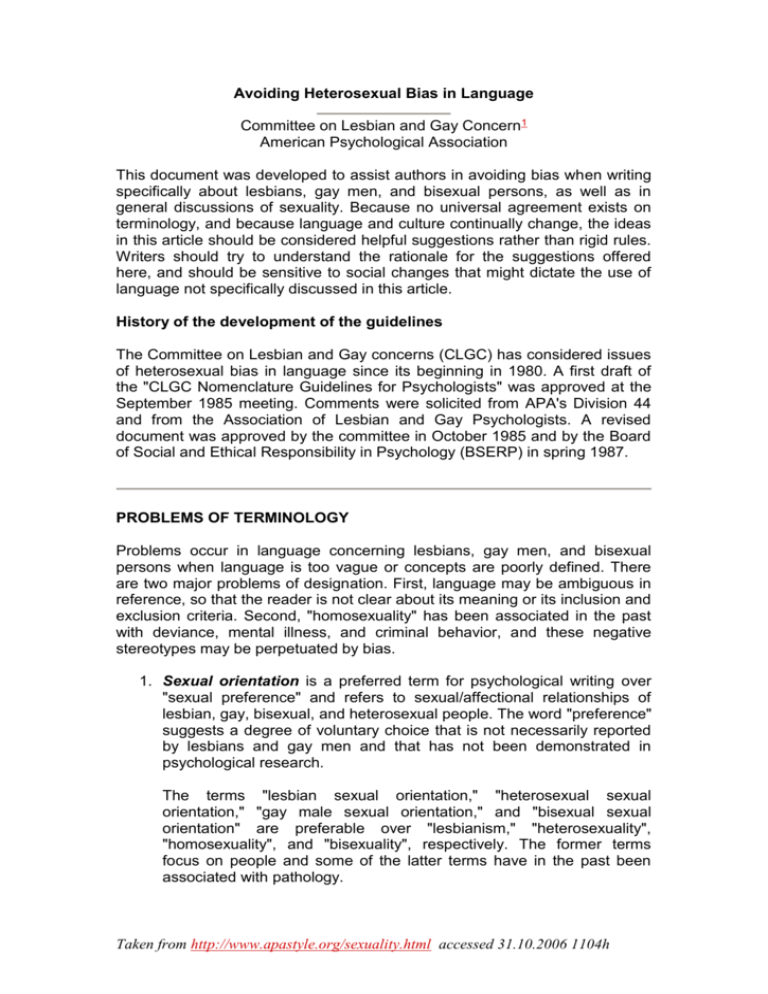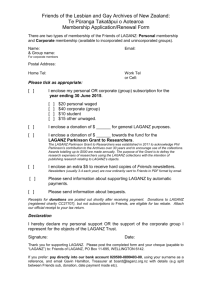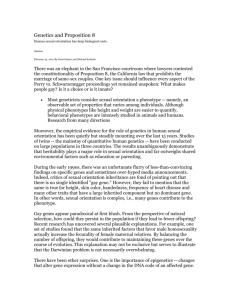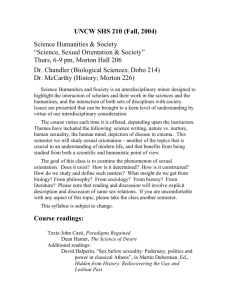
Avoiding Heterosexual Bias in Language
Committee on Lesbian and Gay Concern1
American Psychological Association
This document was developed to assist authors in avoiding bias when writing
specifically about lesbians, gay men, and bisexual persons, as well as in
general discussions of sexuality. Because no universal agreement exists on
terminology, and because language and culture continually change, the ideas
in this article should be considered helpful suggestions rather than rigid rules.
Writers should try to understand the rationale for the suggestions offered
here, and should be sensitive to social changes that might dictate the use of
language not specifically discussed in this article.
History of the development of the guidelines
The Committee on Lesbian and Gay concerns (CLGC) has considered issues
of heterosexual bias in language since its beginning in 1980. A first draft of
the "CLGC Nomenclature Guidelines for Psychologists" was approved at the
September 1985 meeting. Comments were solicited from APA's Division 44
and from the Association of Lesbian and Gay Psychologists. A revised
document was approved by the committee in October 1985 and by the Board
of Social and Ethical Responsibility in Psychology (BSERP) in spring 1987.
PROBLEMS OF TERMINOLOGY
Problems occur in language concerning lesbians, gay men, and bisexual
persons when language is too vague or concepts are poorly defined. There
are two major problems of designation. First, language may be ambiguous in
reference, so that the reader is not clear about its meaning or its inclusion and
exclusion criteria. Second, "homosexuality" has been associated in the past
with deviance, mental illness, and criminal behavior, and these negative
stereotypes may be perpetuated by bias.
1. Sexual orientation is a preferred term for psychological writing over
"sexual preference" and refers to sexual/affectional relationships of
lesbian, gay, bisexual, and heterosexual people. The word "preference"
suggests a degree of voluntary choice that is not necessarily reported
by lesbians and gay men and that has not been demonstrated in
psychological research.
The terms "lesbian sexual orientation," "heterosexual sexual
orientation," "gay male sexual orientation," and "bisexual sexual
orientation" are preferable over "lesbianism," "heterosexuality",
"homosexuality", and "bisexuality", respectively. The former terms
focus on people and some of the latter terms have in the past been
associated with pathology.
Taken from http://www.apastyle.org/sexuality.html accessed 31.10.2006 1104h
2. Lesbian and gay male are preferred to the word "homosexual" when
used as an adjective referring to specific persons or groups, and
lesbians and gay men are preferred terms over "homosexuals" used
as a noun when referring to specific persons or groups. The word
"homosexual" has several problems of designation. First, it may
perpetuate negative stereotypes because of its historical associations
with pathology and criminal behavior. Second, it is ambiguous in
reference because it is often assumed to refer exclusively to men and
thus renders lesbians invisible. Third, it is often unclear.
The terms "gay male" and "lesbian" refer primarily to identities and to
the modern culture and communities that have developed among
people who share those identities. They should be distinguished from
sexual behavior. Some men and women have sex with others of their
own gender but do not consider themselves to be gay or lesbian. In
contrast, the terms "heterosexual" and "bisexual" currently are used to
describe identity as well as behavior.
The terms "gay" as an adjective and "gay persons" as a noun have
been used to refer to both males and females. However, these terms
may be ambiguous in reference since readers who are used to the
term "lesbian and gay" may assume that "gay" refers to men only. Thus
it is preferable to use "gay" or "gay persons" only when prior reference
has specified the gender composition of this term.
Such terms as "gay male" are preferable to "homosexuality" or "male
homosexuality" and so are grammatical reconstructions (e.g., "his
colleagues knew he was gay" rather than "his colleagues knew about
his homosexuality"). The same is true for "lesbian" over "female
homosexual", "female homosexuality", or "lesbianism."
3. Same-gender behavior, male-male behavior, and female-female
behavior are appropriate terms for specific instances of same-gender
sexual behavior that people engage in regardless of their sexual
orientation (e.g., a married heterosexual man who once had a samegender sexual encounter). Likewise, it is useful that women and men
not be considered "opposites" (as in "opposite sex") to avoid
polarization, and that heterosexual women and men not be viewed as
opposite to lesbians and gay men. Thus, male-female behavior is
preferred to the term "opposite sex behavior" in referring to specific
instances of other-gender sexual behavior that people engage in
regardless of their sexual orientation.
When referring to sexual behavior that cannot be described as
heterosexual, gay, lesbian, or bisexual, special care needs to be taken.
Descriptions of sexual behavior among animal species should be
termed "male-male sexual behavior" or "male-female sexual behavior"
rather than "homosexual behavior" or "heterosexual behavior,"
respectively.
Taken from http://www.apastyle.org/sexuality.html accessed 31.10.2006 1104h
4. Bisexual women and men, bisexual persons, or bisexual as an
adjective refer to people who relate sexually and affectionally to women
and men. These terms are often omitted in discussions of sexual
orientation and thus give the erroneous impression that all people
relate exclusively to one gender or another. Omission of the term
"bisexual" also contributes to the invisibility of bisexual women and
men. Although it may seem cumbersome at first, it is clearest to use
the term "lesbians, gay men, and bisexual women or men" when
referring inclusively to members of these groups.
5. Heterosexual as an adjective is acceptable for people who have malefemale affectional/sexual relationships and who do not engage in
sexual relationships with people of the same gender.
6. Use of gender instead of sex. The terms "sex" and "gender" are often
used interchangeably. Nevertheless, the term "sex" is often confused
with sexual behavior, and this is particularly troublesome when
differentiating between sexual orientation and gender. The phrase "it
was sexual orientation, rather than gender, that accounted for most of
the variance" is clearer than "it was sexual orientation, rather than sex,
that accounted for most of the variance."
In the latter phrase, "sex" may be misinterpreted as referring to sexual
activity. It is generally more precise to use the term "gender."
GOALS FOR REDUCING HETEROSEXUAL BIAS IN LANGUAGE
1. Reducing heterosexual bias and increasing visibility of lesbians,
gay men, and bisexual persons.Lesbians, gay men, and bisexual
men and women often feel ignored by the general media which take
the heterosexual orientation of their readers for granted. Unless an
author is referring specifically to heterosexual people, writing should be
free of heterosexual bias. Ways to increase the visibility of lesbians,
gay men, and bisexual persons include:
o Using examples of lesbians, gay men, and bisexual persons
when referring to activities (e.g., parenting, athletic ability) that
are erroneously associated only with heterosexual people by
many readers.
o Referring to lesbians, gay men, and bisexual persons in
situations other than sexual relationships. Historically, the term
"homosexuality" has connoted sexual activity rather than a
general way of relating and living.
o Omitting discussion of marital status unless legal marital
relationships are the object of the writing. Marital status per se is
not a good indicator of cohabitation (marital couples may be
separated; unmarried couples may live together), sexual activity,
or sexual orientation (a person who is married may be in a gay
or lesbian relationship with a partner). Further, describing people
as married or "single" renders lesbians, gay men, and bisexual
Taken from http://www.apastyle.org/sexuality.html accessed 31.10.2006 1104h
o
o
o
persons as well as heterosexual people in cohabiting
relationships invisible.
Referring to sexual and intimate emotional partners by both
male and female pronouns (e.g., "the adolescent males were
asked about the age at which they first had a male or female
sexual partner").
Using sexual terminology that is relevant to lesbians and gay
men as well as bisexual and heterosexual people (e.g., "when
did you first engage in sexual activity?" rather than "when did
you first have sexual intercourse?").
Avoiding the assumption that pregnancy may result from sexual
activity (e.g., "it is recommended that women attending the clinic
who currently are engaging in sexual activity with men be given
oral contraceptives" instead of "it is recommended that women
who attend the clinic be given oral contraceptives").
2. Clarity of expression and avoidance of inaccurate stereotypes
about lesbians and gay men. Stigmatizing or pathologizing language
regarding gay men and lesbians should be avoided (e.g., "sexual
deviate," "sexual invert"). Authors should take care that examples do
not further stigmatize lesbians, gay men, or bisexual persons (e.g., an
example such as "psychologists need training in working with special
populations such as lesbians, drug abusers, and alcoholics" is
stigmatizing in that it lists a status designation (lesbians) with
designations of people being treated.
3. Comparisons of lesbians or gay men to parallel groups. When
comparing a group of gay men or lesbians to others, parallel terms
have not always been used. For example, contrasting lesbians with
"the general public" or to "normal women" portrays lesbians as
marginal to society. More appropriate comparison groups might be
"heterosexual women," "heterosexual men and women," or "gay men
and heterosexual women and men."
Taken from http://www.apastyle.org/sexuality.html accessed 31.10.2006 1104h
PROBLEMATIC AND PREFERRED EXAMPLES
Issues of Designation: Ambiguity of Referent
1. PROBLEMATIC:Sexual preference
PREFERRED: Sexual orientation
Comment: Avoids connotations of voluntary choice that may not
be appropriate.
2. PROBLEMATIC: The sample consisted of 200 adolescent
homosexuals
PREFERRED: The sample consisted of 200 gay male adolescents
The sample consisted of 100 gay male and 100 lesbian adolescents
Comment: Avoids use of "homosexual" and specifies gender of
subjects.
3. PROBLEMATIC: None of the subjects were homosexual or bisexual.
PREFERRED: None of the subjects were lesbians, gay men, or
bisexual persons
All of the subjects were heterosexual
Comment: Avoids use of "homosexual" and increases the
visibility of lesbians.
4. PROBLEMATIC: Manuscript title: "Gay relationships in the 1990s"
PREFERRED: Manuscript title: "Gay male relationships in the 1990s"
Comment: Specifies gender of gay persons before the term gay
is used to describe women and men; avoids invisibility of
lesbians.
5. PROBLEMATIC: Subjects were asked about their homosexuality.
PREFERRED: Subjects were asked about the experience of being a
lesbian or a gay man.
Comment: Changes sentence construction to avoid use of the
term "homosexuality".
6. PROBLEMATIC: The women reported lesbian sexual fantasies.
PREFERRED: The women reported female-female sexual fantasies.
Comment: Avoids confusion of lesbian orientation and specifies
sexual behaviors.
7. PROBLEMATIC: The two bisexual subjects had engaged in both gay
and heterosexual sexual encounters in the past year.
Taken from http://www.apastyle.org/sexuality.html accessed 31.10.2006 1104h
PREFERRED: The two bisexual subjects had engaged in both malemale and male-female sexual encounters in the past year.
Comment: Avoids confusing sexual orientation (bisexual) with
specific sexual behaviors.
8. PROBLEMATIC:
The
male
antelopes
were
bisexual.
PREFERRED: The male antelopes were observed to engage in both
male-male and male-female sexual behavior.
Comment: Increases specificity; does not use sexual orientation
terms with animal species.
9. PROBLEMATIC: It was subjects' sex, not their sexual orientation, that
affected number of friendships.
PREFERRED: It was subjects' gender, not their sexual orientation, that
affected number of friendships.
Comment: Avoids confusing gender with sexual activity.
Problems of Designation: Stereotyping
10. PROBLEMATIC: Homosexual abuse of children.
PREFERRED: Sexual abuse of male children by adult men.
Comment: Does not imply sexual orientation of participants;
does not imply that gay men are rapists.
Problems of Evaluation: Ambiguity of Reference
11. PROBLEMATIC: Questionnaire item: Have you ever engaged in
sexual intercourse?
PREFERRED: Questionnaire item: Have you ever engaged in
penile/vaginal intercourse?
Comment: Increased specificity if penile/vaginal intercourse is
the purpose of the item.
PREFERRED: Have you ever engaged in sexual activity?
Comment: Avoids assumption of heterosexual orientation if
sexual activity is the purpose of the item.
12. PROBLEMATIC: When the mother is employed, her partner may
discover
that
his
share
of
childcare
has
increased.
PREFERRED: When the mother is employed, her partner may
discover that his or her share of childcare has increased.
Taken from http://www.apastyle.org/sexuality.html accessed 31.10.2006 1104h
Comment: Avoids assumption of heterosexuality and is more
precise; increases descriptions of lesbians in nonsexual
situations.
Problems of Evaluation: Stereotyping
13. PROBLEMATIC: Ten subjects were married and five were single.
PREFERRED: Ten subjects were legally married, three were living with
heterosexual partners, and two were living with lesbian partners.
Comment: Increases specificity and avoids assumption of legal
marriage as the only form of committed relationship.
14. PROBLEMATIC: AIDS education must extend beyond the gay male
population into the general population.
PREFERRED: AIDS education must not focus only on selected groups.
Comment: Does not refer to gay men as set apart from the
general population.
15. PROBLEMATIC: Psychologists who work with special populations
(e.g., lesbians, drug abusers, survivors of sexual abuse) need
extra
training.
PREFERRED: Psychologists who work with minority populations
(e.g., Latinos, lesbians, Black women, older women) need extra
training.
Comment: Avoids equating lesbians with pathology.
16. PROBLEMATIC: A client's lesbian sexual orientation may not be the
primary reason for seeking therapy; rather, other issues (e.g., incest,
addictions) may be apparent once therapy has begun.
PREFERRED: A client's lesbian sexual orientation may not be the
primary reason for seeking therapy; rather, other issues (e.g., work
stress, parenting) may be apparent once therapy has begun
Comment: Avoids equating lesbian sexual orientation with
pathology; uses examples often associated only with
heterosexual people.
17. PROBLEMATIC: Women's sexual partners should use condoms.
PREFERRED: Women's male sexual partners should use condoms.
Comment: Avoids assumption of heterosexuality.
Taken from http://www.apastyle.org/sexuality.html accessed 31.10.2006 1104h
ENDNOTES
1The
following people contributed substantially to the development of this
document: Clinton Anderson, Anthony D'Augelli, Linda Garnets, Gregory
Herek, Douglas Kimmel, Letitia Anne Peplau, and Esther Rothblum. This
document represents the "best fit" of the authors' opinions and reflects many
discussions and written drafts.
Meanwhile, in an independent effort, a corresponding document entitled
"Guidelines for Avoiding Racial/Ethnic Bias" was developed by the Board of
Ethnic Minority Affairs (BEMA) and by an ad hoc committee of the
Publications and Communications Board (P&C). Over several revisions by the
authors and several reviews by P&C, the racial/ethnic bias guidelines became
the model for the several working papers being prepared for P&C for use in
an expanded section on language bias of the next edition of the Publication
Manual of the American Psychological Association.
CLGC has continued to revise the "CLGC Nomenclature Guidelines for
Psychologists" to adhere to the format used in the "Guidelines for Avoiding
Racial/Ethnic Bias." The revisions included a change in the title to "Avoiding
Heterosexual Bias in Language." The guidelines were submitted to P&C in
October 1989 and this current edition includes revisions responding to P&C's
comments.
Taken from http://www.apastyle.org/sexuality.html accessed 31.10.2006 1104h








